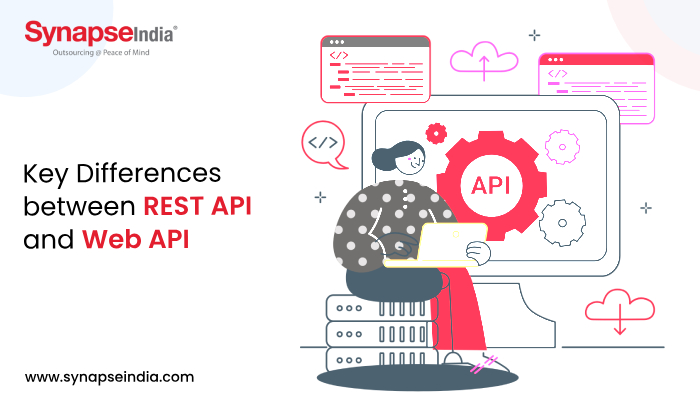 03 Apr 2024
03 Apr 2024“REST API strictly follows the Representational State Transfer principles, while Web API encompasses a broader range of web-based application interfaces, which may not adhere strictly to REST principles.”

To enhance innovation, improve user experiences, and open up new avenues, information must flow seamlessly between software applications. Application Programming Interfaces (APIs) are the backbone of this digital ecosystem, acting as conduct for data sharing, communication, and interaction between apps on the web. By serving as go-betweens, APIs give developers access to the features and assets of other programs or services without requiring them to comprehend the underlying architecture or coding. APIs facilitate digital collaboration and integration by enabling interoperability across disparate systems, platforms, and technologies through the definition of unambiguous interfaces and communication standards.
Inspired by the World Wide Web's architectural principles, Representational State Transfer (REST) API has become a widely used standard for creating stateless, scalable web services. The core idea behind REST APIs is the concept of resources, which may be modified by common HTTP methods like GET, POST, PUT, and DELETE and are uniquely recognized by Uniform Resource Identifiers (URIs).
REST's simplicity and consistency, which encourage a decentralized and resource-centric approach to web service design, are what make it elegant. Through the use of the well-known HTTP protocol for communication and adherence to well-defined criteria like statelessness, cache, and layered system design, REST APIs let programmers create systems that are scalable, resilient, and easily adaptable to changing conditions.
A URI (Uniform Resource Identifier) is used to uniquely identify each resource in a resource-based architecture used by REST API. Standard HTTP methods like GET, POST, PUT, and DELETE are used to manipulate resources, which can represent entities like users, products, or data items.
Because REST APIs are stateless, every request that a client sends to the server is complete with all the data required for the server to respond to it. By not storing any client state on the server in between requests, the system design is more scalable, dependable, and straightforward.
REST API encourages a consistent client-server interface that is simple to use and comprehend. To promote interoperability and consistency across many applications and platforms, it offers standard rules for resource representation (such as JSON or XML), resource manipulation (HTTP methods), and resource identification (URIs).
The client and server are independent entities that communicate with each other through network requests and responses in a client-server architecture, which is the basis of REST API. Greater flexibility and modifiability in the system design are made possible by the independent evolution and scalability of the client and server components made possible by this separation of responsibilities.
Since REST API communication is stateless, every client request includes all the data required for the server to process it. In distributed systems, the lack of client state maintenance by the server facilitates implementation, increases scalability, and boosts reliability.
While REST API represents a specific architectural style for building web services, the term "Web API" encompasses a broader spectrum of interfaces exposed over the web. Web APIs can span various architectural styles, communication protocols, and message formats, catering to diverse use cases, requirements, and preferences.
In addition to RESTful APIs, which adhere to the principles of REST, Web APIs may include interfaces based on other paradigms such as Simple Object Access Protocol (SOAP), Remote Procedure Call (RPC), or custom protocols. This flexibility allows developers to choose the most suitable approach for their specific needs, whether it involves integrating with legacy systems, ensuring interoperability with third-party services, or optimizing for performance and scalability.
Beyond REST, web API includes a broad range of architectural styles, such as GraphQL, RPC (Remote Procedure Call), SOAP (Simple Object Access Protocol), and bespoke protocols. Because of this variety, developers can select the best strategy for their unique needs, be they meeting industry standards, optimizing performance, or integrating with legacy systems.
Numerous communication protocols, such as SOAP, HTTP, HTTPS, WebSockets, and bespoke protocols, are supported by web APIs. Developers can choose the right protocol to enable communication between clients and servers, guaranteeing compatibility, security, and efficiency in data exchange, based on the use case and needs.
Several message formats, including JSON (JavaScript Object Notation), XML (eXtensible Markup Language), Protocol Buffers, and bespoke formats, can be supported by web APIs for encoding data payloads. The interoperability, readability, efficiency, and support for schema validation and versioning are some of the variables that influence the choice of message format.
Web API allows for more design and implementation flexibility than REST API, which is limited by certain architectural requirements. It is up to developers to specify interfaces, protocols, and message formats that are specific to their own use cases, preferences, and limitations.
When it comes to interacting with older technologies and systems that might not follow contemporary architectural trends like REST, web APIs are essential. Web APIs facilitate interoperability with traditional corporate systems, mainframes, and proprietary platforms by supporting protocols like SOAP and RPC. This allows for the preservation of infrastructure investments while modernizing applications.
We have studied the features and definitions of REST and WEB APIs. now let’s discuss some major differences between both of them.
| Feature | REST API | Web API |
|---|---|---|
| Architecture | Follows the REST architectural style | Can encompass various architectural styles (e.g., REST, SOAP, RPC) |
| Communication Protocol | Primarily uses HTTP/HTTPS for communication | Can use HTTP/HTTPS, SOAP, or custom protocols |
| State Management | Stateless; each request contains all necessary information | Maybe stateless or stateful depending on the implementation |
| Flexibility and Extensibility | Emphasizes uniform interface and resource-based architecture | Offers greater flexibility in design and implementation |
| Performance and Scalability | Known for simplicity, performance, and scalability | Performance and scalability depend on the implementation |
| Tooling and Ecosystem | Benefits from a mature ecosystem of tools and frameworks for RESTful API development | May have a diverse ecosystem of tools and technologies |
The foundation of contemporary software development is APIs, which provide cooperation, interoperability, and smooth integration across various platforms and systems. Developers have an abundance of tools and technologies at their disposal to unleash the power of connectivity and drive innovation in the digital age, whether they want to embrace the flexibility and diversity of Web API or leverage the simplicity and scalability of REST API. Building the next wave of revolutionary applications and services will require a mastery of API design and integration, as the desire for interconnection only grows.


 09 Aug 2023
09 Aug 2023
